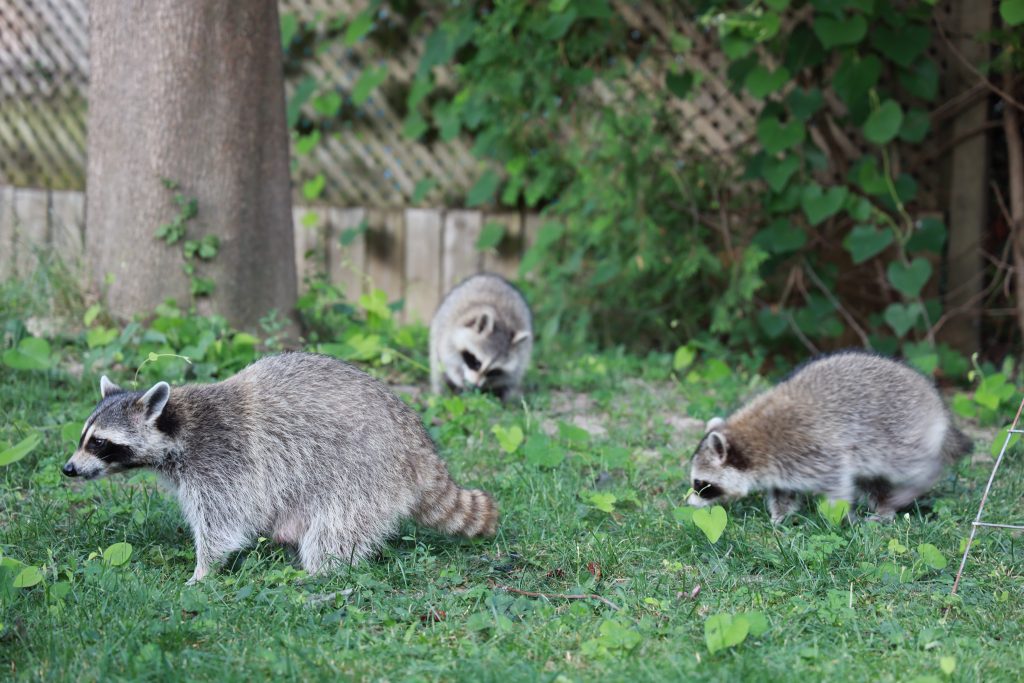Wherever you may live, you share your property is also a natural habitat for a host of animals. Wildlife like raccoons, squirrels, bats, birds, skunks, and more have adapted to live near humans. Unmanaged wildlife in your yard can introduce some risks.
Animals in Trash Cans or Garbage Bins
Trash, especially the scraps of human food found in most outdoor trash bins, make up a major portion of many animal diets, including those of raccoons, squirrels, opossums, rats, and skunks. When other naturally occurring food sources are scarce or inaccessible, these pests must get creative to sustain themselves.
Trash cans full of rotting fruit and meat remain to provide enough sustenance until garbage-raiding critters can find more satisfying meals.
Was There an Animal in My Trash?
As raccoons, rodents, opossums, and skunks are all messy eaters, they’ll leave behind telltale signs of their presence after a night of rooting through the garbage.
The most obvious indication that there have been animals in the trash is debris scattered across the yard. Portions of ripped-up trash bags, napkins, and other non-edible garbage will be tossed aside in the search for scraps of food.
Additionally, property owners may notice gnaw marks on trash bins and bin lids when animals have been rooting through the garbage, as well as piles of excrement hidden around yards.
Keep Wildlife Out of Trash
The presence of garbage-raiding pests in lawns can be detrimental to the health of nearby humans.
- Carry transmissible diseases
- Increase exposure to diseases and harmful bacterium from excrement
- Increase risk of property damage and animal entry into your home
For these reasons, property owners should call professional wildlife control services at the first sign of animal activity in the trash.
Nuisance Wildlife in Your Yard

Animals are attracted to human settlements by the promise of shelter, food, and safety.
Squirrels, raccoons, and birds seek shelter in well-kept ornamental trees, unused attics, and open garages as these places are ideal for building nests and raising young.
Deer, opossums, and skunks feast on readily available food sources in backyard gardens, bird feeders, manicured lawns, and trash bins.
Backyards also offer safety from natural predators like wolves, bears, and coyotes.
Although animals in the backyard may seem preferable to infestations in the home, these pests are hazards to human health and safety even when they stay outside.
Signs of Animals in Your Yard
Noticing infestations of animals in the backyard is easy because property owners are usually able to see the pests in action. Birds fly about tree branches and squirrels hop across the ground. In the evening, raccoons can be found around trash cans foraging for tasty leftovers.
However, some backyard invaders are more secretive and will not be spotted so easily. As such, homeowners should regularly examine yards for animal droppings, tracks, and damage like scratched tree bark or freshly dug holes.
Problems with Animals in Your Trees
Allowing nuisance animals to remain in trees near homes increases the risk of household infestations. Trees offer many animals sources of food and shelter.
Birds, reptiles, insects, and mammals all frequently take up residence in ornamental lawn trees. Birds construct large nests high among sturdy tree branches where they raise chicks. Tree snakes and iguanas are adapted to climb trees for shelter.
Signs of Activity
The best way to tell if animals have started living in trees on private properties is too pay close attention to rustling leaves and branches, which indicates activity. Additionally, individuals should look for hollows large enough to hold pests and be alert for newly constructed nests. Finally, droppings will collect around the base of the tree. Inspection of the excrement can indicate what types of animals have taken up residence in the yard.
Reasons for Removal from Trees
Although some creatures are a pleasure to observe and interact with, backyards, houses, and residential areas are not meant for wild animals. Some animals scratch bark off trees with claws or antlers, while others, like beavers, chop down trees to use as construction material. A few common pests strip branches of leaves and certain insects boreholes in tree trunks to make nests or search for food. Bird roosts can damage branches and leave large deposits of droppings below that are hazardous to humans.
Professional Wildlife Removal from Property
Trutech® provides solutions for all your animal, pest, and wildlife control needs. We have a long history of providing customers with quality services, coupled with a high standard of professionalism. Trutech is fully insured and licensed with regulatory agencies and state and local authorities.
Trutech has branches across the country including Dallas–Fort Worth, San Antonio, Richmond, Boston, Charleston, Savannah, Orlando, Fort Myers, Sarasota, Asheville, Raleigh–Durham, and more.
Our mission is to earn the confidence of the people we serve by offering quality solutions to their evolving needs and challenging ourselves to deliver the highest level of customer satisfaction. At Trutech®, we help protect our customers from the hazards of wildlife in their homes and businesses while ensuring animals are removed in a humane and ethical manner. And, our quality services are provided in an environmentally sensitive manner.
Trutech® is your source for animal control and removal and wildlife removal. We have a team of professionals on staff that is dedicated to servicing your needs. Not only do you have direct communication with expert technicians, but you have access to the entire staff. Our team is committed to you.


